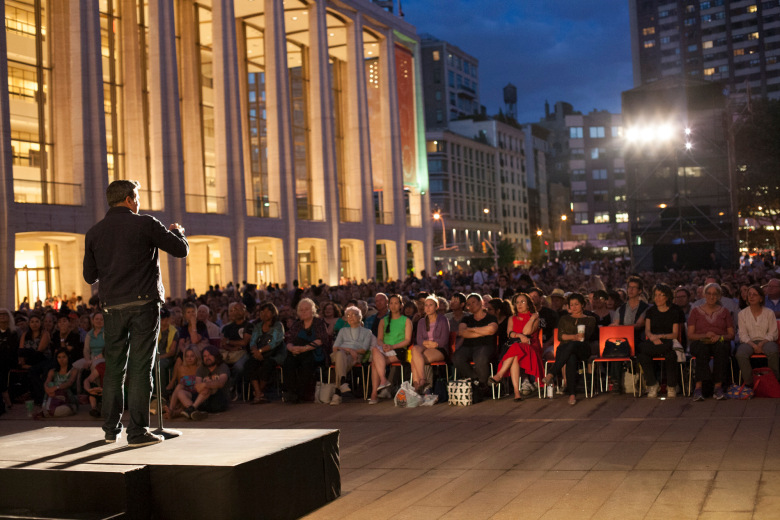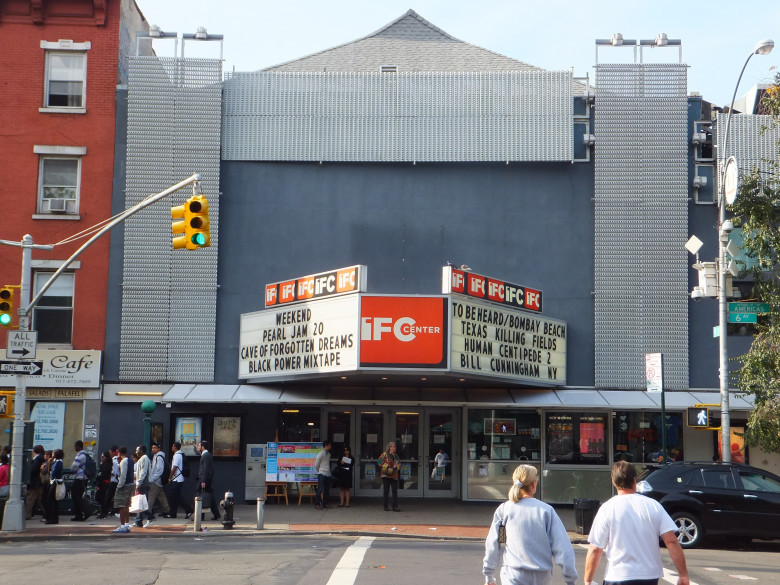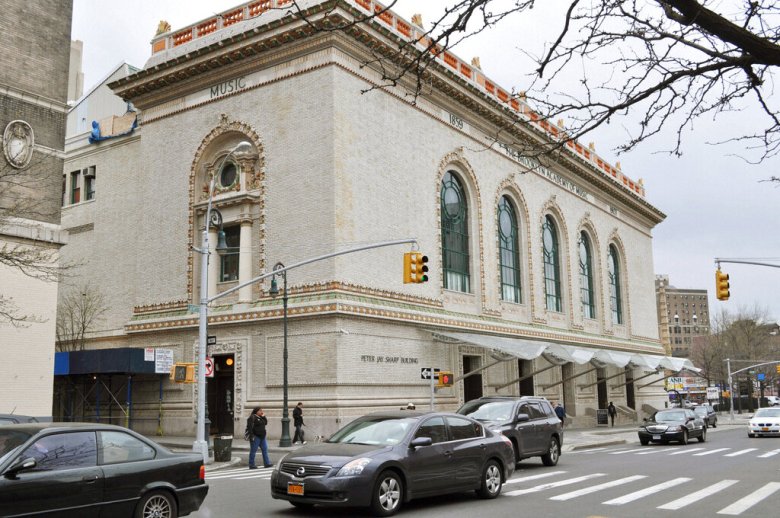April 28 was opening night of New York’s first in-person film festival in more than a year. The 50th edition of New Directors/New Films opened with a screening of “El Planeta,” the black-and-white debut feature of Argentinian filmmaker Amalia Ulman, who also stars as a wayward fashion designer at the mercy of her mother. Introducing the film, Ulman joked that she was less nervous now that she had a little bit to drink.
“I’m very happy you’re all here,” she said . “Today was my first time going back to the theater after a year. I love going to the movies here in New York.”
That sentiment pervaded the sold-out audience at Lincoln Center’s Walter Reade theater, but it also meant the 268-seat screening room could only accommodate 50. Current capacity limits are 33 percent; other regulations require one empty row between all occupied ones. An usher had to comb the aisles to remind some viewers to mask up. Still, it was enough to create the impression of a crowd; audiences laughed throughout and applauded over the credits.
As the pandemic eases its grip, the city at the center of arthouse cinema in the U.S. faces new crossroads. Every major film institution is taking a different approach toward recovery, but for all of them, it’s a long way to normal.
The Tribeca Film Festival announced a lineup of 53 feature films for a 12-day festival June 9-20. That includes opening-night selection “In the Heights,” set to premiere at the United Palace and broadcast simultaneously at outdoor screenings in all five boroughs. The festival plans outdoor screenings for almost all of its lineup, including daytime viewings on giant LED screens. “After a year of closed cinemas, canceled gatherings, and virtual everything, it is with joy and hope that we finally invite New Yorkers out of their homes and back to the movies,” festival director Cara Cusumano said in a statement announcing the lineup.

Eugene Hernandez hosts “West Side Story” at Lincoln Center Plaza in summer 2015
Adele Major
Holding a vast outdoor screening series in the middle of a bustling New York summer is a logistical challenge even without COVID-era restrictions. “No one really knows what capacities are going to be like even outdoors,” said Rooftop Films director Dan Nuxoll. Rooftop’s usual summer series aims for a late June start, but Nuxoll — who helped New York Film Festival navigate the logistical challenges of its fall 2020 drive-ins — said it’s impossible to determine the scale of the events.
For example, New York currently allows outdoor gatherings of up to 200 people; that number rises to 500 if everyone has proof of a negative COVID test. “That will shift, but no one really knows when,” Nuxoll said. “Under normal circumstances, 200 is our bottom line. Normally, we have plenty of screenings in parks where we have 3,000 people. Eliminating that entirely from our series isn’t ideal.” He hopes for regulations that require attendees to show proof of vaccination. “Providing a picture of the vaccination card is just like showing your ID, which everyone does at our shows anyway if they’re drinking,” he said.
Jon Dieringer, who founded weekly newsletter Screen Slate in 2011 to track weekly movie options in NYC, pivoted into coverage of streaming options when the pandemic hit. He now plans to maintain that focus. “We’re not going to be like, ‘So long New York listings, we’re a streaming website now,'” he said. “But we’d still like to cover this emerging streaming culture. For us it’s just a matter of feeling out what’s going to be possible as we resume something resembling our old lives.”

The IFC Center
IFC Center, one of the first arthouses to reopen in early March, has a full schedule of first-run offerings slated through early August as well as Charles Burnett and Catherine Breillat retrospectives. Film Forum, which reopened April 2, continues to juggle first-run features with repertory screenings; it plans to announce a summer slate.
“There’s a period of getting reacquainted that’s happening right now,” said Film at Lincoln Center deputy and NYFF director (and IndieWire co-founder) Eugene Hernandez, who will oversee the return of the New York Film Festival this fall with Film at Lincoln Center executive director Lesli Klainberg. “The response from membership that we’re open has been so tremendous. It’s so moving to see what it means to people to come through the door.”
Lincoln Center reopened its two theaters at the Elinor Bunin Munroe Film Center April 16; the Walter Reade followed two weeks later. So far, it is the only arts institution within Lincoln Center to exhibit its offerings to the public. Meanwhile, Hernandez and Klainberg are trying to determine how to best leverage the institution’s digital presence. Film at Lincoln Center pivoted to virtual cinema early in the pandemic. “We’re going to keep at it,” Klainberg said. “This whole process of shutting down and considering what digital platforms can do has brought us much closer together.”
With Lincoln Center’s Alice Tully Hall on track to reopen in September, Klainberg is vying for space to hold NYFF in the vast 1,100-seat auditorium even as it accommodates the Philharmonic and Jazz at Lincoln Center. (Their own venues will not have reopened by then.) Film at Lincoln Center’s first-run calendar is booked through the summer, along with a Wong Kar Wai retrospective and highlights of last year’s NYFF selections. Partner festivals may also return this summer, including the Asian Film Festival, Dance on Camera, Human Rights Watch, and the African Film Festival.
Down the street at MOMA, chief film curator Rajendra Roy said the museum’s online streaming service will become a permanent feature for its 100,000 members. “We had the privilege of having a built-in base,” Roy said, noting that the service is now available to non-members for a $110 annual subscription as well. “We’re not trying to make up revenue; we’re trying to hold our audience.”
Instead of reopening MOMA’s two screening rooms throughout the week, Roy said the museum planned to kickstart a series of outdoor screenings in the museum’s garden by Memorial Day. Indoor screenings will likely take place during museum hours, where one screening room will feature titles from the MOMA collection. “We want it to be an exciting offering,” he said, “and not just say, ‘Phew we’re back, let’s pick up where left off.’”

BAM in downtown Brooklyn
Kyodo
The Museum of the Moving Image reopens this week with the return of its exhibit “Envisioning 2001: Stanley Kubrick’s Space Odyssey” on display until the fall. The 267-seat Redstone Theater will reopen with a retrospective of Kubrick films as well as its popular “See It Big!” series and “First Look 20/21,” a variation on its First Look film series that includes leftovers from last year.
Elsewhere, ambiguity reigns. BAM plans to reopen in early summer, but with no specific date confirmed yet. During the pandemic, its film programming staff dwindled from a three-person operation to a staff of one as vice president Gina Duncan left to run operations at Sundance and director of film programming Ashley Clark took a curatorial job at Criterion.
Programmer Jesse Trussell said he expected the team to expand in the foreseeable future; in the meantime, he maintains BAM’s virtual programming and hopes to host physical screenings for partner festivals, including the Animation Block Party and Contemporary Arab Cinema festivals, by early next year.
“I don’t think anyone would say that virtual cinema is blowing the doors off,” Trussell said. “But it’s less about being a revenue driver than this value of access, so we can still reach people who can’t come to BAM.”
Metrograph, the hip two-screen screening venue that opened to much fanfare in 2016, sees things differently. The brainchild of fashion maverick and filmmaker Alexander Olch, it remains closed; he declined to comment for this story. However, sources suggested that the theater is exploring a plan that would call for part-time reopening while investing in Metrograph Digital, the online presence it launched during the pandemic.
Whatever the next weeks and months bring for the city, its active curators continue to push an optimistic message, one informed by their own participation as audiences as well as influencers. When he lived in Austin, BAM’s Trussell followed New York’s cinema listings from afar; he insisted that nothing will stop the city from retaining its cultural currency. “It’s a film festival every day,” he said. “New York has been the epicenter of movies for so long. People are excited to come back and gather again. That’s what we want to serve — that community hub that’s really a useful part of people’s lives.”
“I’m very happy you’re all here,” she said . “Today was my first time going back to the theater after a year. I love going to the movies here in New York.”
That sentiment pervaded the sold-out audience at Lincoln Center’s Walter Reade theater, but it also meant the 268-seat screening room could only accommodate 50. Current capacity limits are 33 percent; other regulations require one empty row between all occupied ones. An usher had to comb the aisles to remind some viewers to mask up. Still, it was enough to create the impression of a crowd; audiences laughed throughout and applauded over the credits.
As the pandemic eases its grip, the city at the center of arthouse cinema in the U.S. faces new crossroads. Every major film institution is taking a different approach toward recovery, but for all of them, it’s a long way to normal.
The Tribeca Film Festival announced a lineup of 53 feature films for a 12-day festival June 9-20. That includes opening-night selection “In the Heights,” set to premiere at the United Palace and broadcast simultaneously at outdoor screenings in all five boroughs. The festival plans outdoor screenings for almost all of its lineup, including daytime viewings on giant LED screens. “After a year of closed cinemas, canceled gatherings, and virtual everything, it is with joy and hope that we finally invite New Yorkers out of their homes and back to the movies,” festival director Cara Cusumano said in a statement announcing the lineup.

Eugene Hernandez hosts “West Side Story” at Lincoln Center Plaza in summer 2015
Adele Major
Holding a vast outdoor screening series in the middle of a bustling New York summer is a logistical challenge even without COVID-era restrictions. “No one really knows what capacities are going to be like even outdoors,” said Rooftop Films director Dan Nuxoll. Rooftop’s usual summer series aims for a late June start, but Nuxoll — who helped New York Film Festival navigate the logistical challenges of its fall 2020 drive-ins — said it’s impossible to determine the scale of the events.
For example, New York currently allows outdoor gatherings of up to 200 people; that number rises to 500 if everyone has proof of a negative COVID test. “That will shift, but no one really knows when,” Nuxoll said. “Under normal circumstances, 200 is our bottom line. Normally, we have plenty of screenings in parks where we have 3,000 people. Eliminating that entirely from our series isn’t ideal.” He hopes for regulations that require attendees to show proof of vaccination. “Providing a picture of the vaccination card is just like showing your ID, which everyone does at our shows anyway if they’re drinking,” he said.
Jon Dieringer, who founded weekly newsletter Screen Slate in 2011 to track weekly movie options in NYC, pivoted into coverage of streaming options when the pandemic hit. He now plans to maintain that focus. “We’re not going to be like, ‘So long New York listings, we’re a streaming website now,'” he said. “But we’d still like to cover this emerging streaming culture. For us it’s just a matter of feeling out what’s going to be possible as we resume something resembling our old lives.”

The IFC Center
IFC Center, one of the first arthouses to reopen in early March, has a full schedule of first-run offerings slated through early August as well as Charles Burnett and Catherine Breillat retrospectives. Film Forum, which reopened April 2, continues to juggle first-run features with repertory screenings; it plans to announce a summer slate.
“There’s a period of getting reacquainted that’s happening right now,” said Film at Lincoln Center deputy and NYFF director (and IndieWire co-founder) Eugene Hernandez, who will oversee the return of the New York Film Festival this fall with Film at Lincoln Center executive director Lesli Klainberg. “The response from membership that we’re open has been so tremendous. It’s so moving to see what it means to people to come through the door.”
Lincoln Center reopened its two theaters at the Elinor Bunin Munroe Film Center April 16; the Walter Reade followed two weeks later. So far, it is the only arts institution within Lincoln Center to exhibit its offerings to the public. Meanwhile, Hernandez and Klainberg are trying to determine how to best leverage the institution’s digital presence. Film at Lincoln Center pivoted to virtual cinema early in the pandemic. “We’re going to keep at it,” Klainberg said. “This whole process of shutting down and considering what digital platforms can do has brought us much closer together.”
With Lincoln Center’s Alice Tully Hall on track to reopen in September, Klainberg is vying for space to hold NYFF in the vast 1,100-seat auditorium even as it accommodates the Philharmonic and Jazz at Lincoln Center. (Their own venues will not have reopened by then.) Film at Lincoln Center’s first-run calendar is booked through the summer, along with a Wong Kar Wai retrospective and highlights of last year’s NYFF selections. Partner festivals may also return this summer, including the Asian Film Festival, Dance on Camera, Human Rights Watch, and the African Film Festival.
Down the street at MOMA, chief film curator Rajendra Roy said the museum’s online streaming service will become a permanent feature for its 100,000 members. “We had the privilege of having a built-in base,” Roy said, noting that the service is now available to non-members for a $110 annual subscription as well. “We’re not trying to make up revenue; we’re trying to hold our audience.”
Instead of reopening MOMA’s two screening rooms throughout the week, Roy said the museum planned to kickstart a series of outdoor screenings in the museum’s garden by Memorial Day. Indoor screenings will likely take place during museum hours, where one screening room will feature titles from the MOMA collection. “We want it to be an exciting offering,” he said, “and not just say, ‘Phew we’re back, let’s pick up where left off.’”

BAM in downtown Brooklyn
Kyodo
The Museum of the Moving Image reopens this week with the return of its exhibit “Envisioning 2001: Stanley Kubrick’s Space Odyssey” on display until the fall. The 267-seat Redstone Theater will reopen with a retrospective of Kubrick films as well as its popular “See It Big!” series and “First Look 20/21,” a variation on its First Look film series that includes leftovers from last year.
Elsewhere, ambiguity reigns. BAM plans to reopen in early summer, but with no specific date confirmed yet. During the pandemic, its film programming staff dwindled from a three-person operation to a staff of one as vice president Gina Duncan left to run operations at Sundance and director of film programming Ashley Clark took a curatorial job at Criterion.
Programmer Jesse Trussell said he expected the team to expand in the foreseeable future; in the meantime, he maintains BAM’s virtual programming and hopes to host physical screenings for partner festivals, including the Animation Block Party and Contemporary Arab Cinema festivals, by early next year.
“I don’t think anyone would say that virtual cinema is blowing the doors off,” Trussell said. “But it’s less about being a revenue driver than this value of access, so we can still reach people who can’t come to BAM.”
Metrograph, the hip two-screen screening venue that opened to much fanfare in 2016, sees things differently. The brainchild of fashion maverick and filmmaker Alexander Olch, it remains closed; he declined to comment for this story. However, sources suggested that the theater is exploring a plan that would call for part-time reopening while investing in Metrograph Digital, the online presence it launched during the pandemic.
Whatever the next weeks and months bring for the city, its active curators continue to push an optimistic message, one informed by their own participation as audiences as well as influencers. When he lived in Austin, BAM’s Trussell followed New York’s cinema listings from afar; he insisted that nothing will stop the city from retaining its cultural currency. “It’s a film festival every day,” he said. “New York has been the epicenter of movies for so long. People are excited to come back and gather again. That’s what we want to serve — that community hub that’s really a useful part of people’s lives.”


